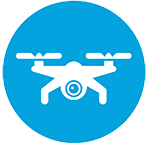Maximising ROI with Commercial Drones
In recent years, commercial drones have transitioned from novel gadgets to essential tools across various industries. Their ability to perform tasks more efficiently, safely, and cost-effectively than traditional methods has revolutionized operations in fields such as agriculture, construction, and logistics. This blog explores how companies are leveraging drones to maximise their return on investment (ROI) through real-world examples and a breakdown of cost benefits.
Agriculture: Precision Farming and Yield Optimisation
Case Study: AgEagle Aerial Systems
Challenge: Traditional farming methods often result in uneven crop health monitoring and resource distribution, leading to wasted resources and suboptimal yields.
Solution: AgEagle Aerial Systems utilizes drones equipped with multispectral sensors to capture detailed aerial images of crops. These images are analyzed to identify areas needing attention, such as irrigation, fertilisation, or pest control.
Cost Benefits:
- Resource Efficiency: Precise application of water, fertilizers, and pesticides reduces waste.
- Increased Yields: Targeted interventions improve crop health and productivity.
- Labour Savings: Automated monitoring reduces the need for manual field inspections.
ROI: Farmers using AgEagle’s drone technology have reported a 20-40% reduction in resource use and a 10-15% increase in crop yields, leading to significant cost savings and revenue boosts.
Construction: Enhancing Site Surveys and Safety
Case Study: Komatsu Smart Construction
Challenge: Traditional construction site surveys are time-consuming, labour-intensive, and often require shutting down parts of the site, leading to delays and increased costs.
Solution: Komatsu’s Smart Construction initiative integrates drones to conduct aerial surveys, create 3D models, and monitor progress in real-time.
Cost Benefits:
- Speed: Drones complete surveys in a fraction of the time compared to ground crews.
- Accuracy: High-resolution imagery and 3D mapping enhance precision in planning and execution.
- Safety: Drones eliminate the need for workers to access potentially hazardous areas.
ROI: Companies using Komatsu’s drone solutions report up to a 50% reduction in survey times and a 25% decrease in project completion times, translating to substantial savings on labor and overhead costs.
Logistics: Streamlining Deliveries and Inventory Management
Case Study: Amazon Prime Air
Challenge: Traditional delivery methods are often hindered by traffic, labour costs, and logistical inefficiencies, leading to higher operational costs and longer delivery times.
Solution: Amazon Prime Air uses drones for last-mile deliveries, reducing the reliance on ground transportation and enabling faster, more flexible delivery options.
Cost Benefits:
- Speed: Drones can bypass traffic and take more direct routes, cutting delivery times.
- Cost Reduction: Lower fuel and labour costs compared to traditional delivery vehicles.
- Inventory Management: Drones equipped with RFID scanners can efficiently conduct inventory checks in warehouses.
ROI: Amazon reports that drone deliveries could reduce last-mile delivery costs by up to 40%, significantly enhancing profitability.
Infrastructure: Inspecting and Maintaining Assets
Case Study: SkySpecs for Wind Turbine Inspections
Challenge: Inspecting wind turbines is hazardous, time-consuming, and requires significant manual labour, often leading to downtime and high maintenance costs.
Solution: SkySpecs employs autonomous drones to inspect wind turbines, capturing detailed images and identifying potential issues without shutting down the turbines.
Cost Benefits:
- Safety: Reduces the need for workers to perform high-risk inspections.
- Downtime Reduction: Inspections are conducted without stopping turbine operations.
- Efficiency: Faster and more frequent inspections allow for proactive maintenance.
ROI: Wind farm operators using SkySpecs’ technology have seen maintenance costs drop by up to 30% and turbine uptime increase, leading to higher energy production and revenue.
Conclusion
Commercial drones offer a transformative approach to various industries by enhancing efficiency, reducing costs, and improving safety. These case studies highlight the significant ROI that companies can achieve by integrating drone technology into their operations. As drone technology continues to advance, the potential for further cost benefits and operational improvements will only grow, making drones an indispensable asset for businesses aiming to stay competitive and maximise their ROI.

